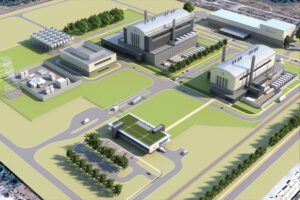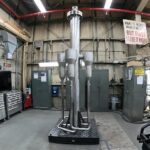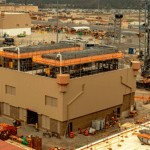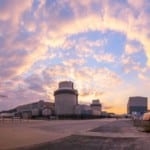One of the biggest challenges the nuclear power industry faces is building plants on time and on budget. Having an experienced project team with the right leaders driving the bus, so to speak, can mean the difference between failure and success.
Nuclear power plants are large and complex facilities. Constructing one costs billions of dollars and takes many years to complete. In fact, over the decade 2014–2023, the World Nuclear Industry Status Report 2024 says the average construction time for a nuclear unit was 9.9 years. Its research looked at 67 reactors completed in 11 different countries. Notably, more than half of the reactors (37) were built in China, which had the second-lowest mean construction time at 6.3 years per unit behind only Pakistan’s 5.6 years per unit. The majority of other countries took well over 10 years on average to complete nuclear plants with two clocking in at more than three decades each.
Yet, no project begins with a 10-year timeline as its goal. Of the 18 reactors connected to the grid in 2021–2023, all of them began with an expected construction time between 4.3 years and 6.5 years. Only one of those 18 units—the Chinese-designed and -built Tianwan Unit 6—started up on-time. Several of the other units took more than twice the expected duration.
“These are extremely hard things to build. These are mega projects costing tens of billions of dollars,” Chandu Bolisetti, senior scientist at the Idaho National Laboratory (INL), told POWER. “All over the world, mega projects are often delayed. They’re often over budget and over schedule. They’re hard to execute.”
Getting Off to a Good Start
Before a nuclear plant construction project breaks ground and the clock starts ticking, many years are often spent behind the scenes doing preliminary work. Power companies must evaluate electricity supply and demand projections, and if a nuclear plant is deemed necessary, they must consider all the infrastructure needed to support a project. Feasibility studies and environmental impact assessments are required. The specific technology and design to be deployed must be evaluated and selected, along with the mode of execution, such as turnkey, EPC (engineering, procurement, and construction), or some other contractual arrangement. All of this takes time and dedicated resources.
The International Atomic Energy Agency (IAEA) has provided guidance in a 139-page document designed to improve project management in nuclear power plant construction. It suggests deploying nuclear technology often requires a parallel social and economic development plan, ensuring a culture of safety and protection of the environment is top-of-mind, and establishing effective working relationships with government institutions.
For companies intending to develop a greenfield location, the site selection and acquisition process can be time-consuming, requiring considerations such as:
- ■ Proximity to large industrial consumers of electricity.
- ■ Availability of skilled and semi-skilled manpower in the vicinity of the proposed plant.
- ■ Adequacy of the approach roads or waterways for the transportation of over-dimensioned equipment typical of nuclear power plants.
- ■ Adequate water and power supply.
- ■ Favorable perception regarding nuclear plants amidst the local population.
Creating an Effective Team
The IAEA pointed to the establishment of a well-defined project management organization as being vital to success. “A written instruction from the organization’s top management announcing the appointment of the project manager should immediately follow the contract effective date,” it says. “Since large amounts of materials and equipment must be ordered, manufactured and installed during this phase and the human resource profile reaches its peak, this is also when the largest part of the overall cost occurs and the highest degree of coordination is most necessary. It is during this phase that project management has to show its strength and use all the tools at its disposal.”
The contract effective date represents a major milestone in project work. It is at this point that the project ceases to be merely a planning exercise and becomes an actual implementation of construction and installation work in the field. “Clear and well-defined commitments should exist between the project partners and signed at the highest management level, expenditures begin to incur in orders of magnitude higher than before. Each day lost on a critical activity may now affect the schedule and cost,” the IAEA says.
The Organisation for Economic Co-operation and Development’s (OECD’s) Nuclear Energy Agency (NEA) has also published a practical guide for reducing nuclear construction costs. In its 134-page document, the NEA agrees that having a strong and dedicated project team led by an effective project manager is essential to success. “The importance of leadership in managing nuclear new-build projects cannot be overstated,” it says.
“Regardless of the procurement approach chosen, given the scale and complexity of a nuclear new-build project, it is very important to develop a dedicated project team structure with sufficient resources and empowerment to enable competent leadership and ensure timely decision-making,” the NEA guide notes.
The project owner/operator (in most cases, the future utility) is central to the acquisition strategy, according to the NEA, and its active involvement needs to be maintained throughout the project. “A systematic approach to acquisition especially helps the owner to be prepared to react to changing situations,” the guide says.
The project team is usually responsible for developing the detailed design, securing the safety case, and planning the procurement and construction schedule. It will also collaborate with the supply chain and with external stakeholders, including the local community, to address emerging environmental and social issues, for example. The project team must have a strong team leader reporting directly to the organization’s top-level management.
Contrasting Case Studies
Two relatively recent projects in the U.S.—Plant Vogtle Units 3 and 4, and V.C. Summer Units 2 and 3—demonstrate the importance of experience and sound leadership when it comes to nuclear plant construction. Both projects set out to utilize the Westinghouse AP1000 design and both began with the same main construction contractor—Stone & Webster (S&W), part of The Shaw Group. According to the NEA, S&W originated as an engineering company in the oil sector and had no previous nuclear experience. Consequently, the company’s senior management initially underestimated the challenges of new nuclear construction, particularly the quality requirements, and their lack of experience contributed to recurring quality assurance issues.
In the case of the V.C. Summer project, the NEA said the lack of experience also led to a situation in which the plans and schedules were not reflective of the actual project situation. A deeper dive into the history of the project suggests fraud also played a role. At least two former executives of SCANA Corp., the majority owner of the project, served prison time for conspiracy to cover up problems at the V.C. Summer site, where Units 2 and 3 were ultimately abandoned (Figure 1).
 |
|
1. This image of the V.C. Summer Nuclear Station in South Carolina was taken on Sept. 18, 2017, after project owners SCANA Corp. and Santee Cooper ceased construction of Units 2 and 3 earlier that year. The companies said the decision was prompted by analysis of detailed schedule and cost data, and would save customers nearly $7 billion. Courtesy: High Flyer © 2017 |
The Plant Vogtle expansion experienced some of the same schedule and cost overrun issues that the Summer project did, but its leaders managed to avoid criminal wrongdoing. When the Plant Vogtle project owners in 2017 took a close look at project completion estimates and evaluated whether to continue or abandon the job, they chose Bechtel, a global EPC contractor with extensive nuclear experience, to take over day-to-day construction of the new units under the direction of Southern Nuclear, a Southern Co. subsidiary, which operates Units 1 and 2 at the site near Waynesboro, Georgia. While the changes did not completely eliminate schedule delays and cost overruns, they did set a clear path to project completion, and the units were ultimately brought online, with Unit 3 entering commercial operation on July 31, 2023, and Unit 4 following on April 29, 2024 (Figure 2).
 |
|
2. Plant Vogtle Units 3 and 4 were completed in 2023 and 2024, respectively. The project won POWER’s 2024 Plant of the Year award in recognition of the achievement. Courtesy: Georgia Power Company |
Bolisetti said the Vogtle expansion had added complexity because it was essentially a first-of-a-kind mega project. “I’m not surprised that these units were over budget and over schedule,” he said. “The fact that they pulled it off is impressive and proof that we can still build large plants in this country.”
Nonetheless, these projects underscore the need for plant owners to establish an experienced, dedicated, and honest project management organization to ensure that the consortium’s contractors are fulfilling their contractual obligations. The NEA said these two projects’ initial lack of resources in this area contributed to conflict between the EPC consortium, led by Westinghouse, and the plant owners, which hindered rapid and non-litigious adjustments to unanticipated changes in requirements or subcontractor performance. This also amplified contractual challenges that arose within the projects, according to the NEA.
Developing Experience
Yet, Bolisetti suggested that finding experienced people to fill nuclear construction teams won’t be easy, at least for a while. “There has been a huge lull in nuclear construction for the last few decades before they started building these plants in the late 2000s,” he told POWER. “With that kind of a lull—with that kind of loss of expertise and experience, and loss of supply chain—you can’t blame the industry for being the way it is, because that’s just what happens when you have a huge lull and loss of talent.”
Abdalla Abou Jaoude, INL’s deputy director for the System Analysis & Integration Program, suggested the best way to gain experience is to construct plants. “The silver bullet is to build many of them in a consistent fashion, capturing learning from one year to the next, having the same design team, the same EPC firms, the same specifications,” he said. “Everything that you do for the first time is going to be very expensive and very difficult to do. It’s not a question of changing something or innovating anywhere, necessarily, it’s primarily a question of rolling up our sleeves, doing it over and over again, and being consistent.”
—Aaron Larson is POWER’s executive editor.











